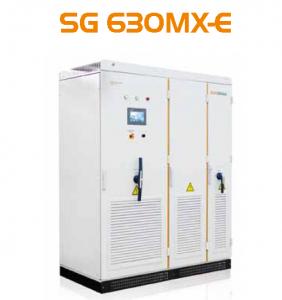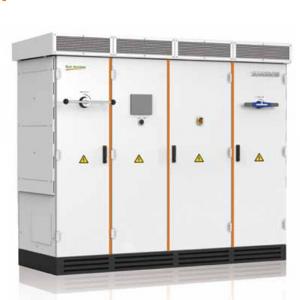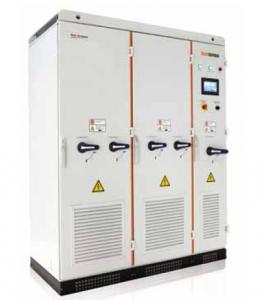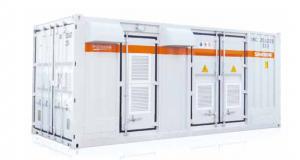Photovoltaic Grid-Connected Inverter SG630MX-E Solar Inverter
- Loading Port:
- China Main Port
- Payment Terms:
- TT or LC
- Min Order Qty:
- 10 unit
- Supply Capability:
- 1000 unit/month
OKorder Service Pledge
OKorder Financial Service
You Might Also Like
1. Structure of Photovoltaic Grid-Connected Inverter SG630MX-E Description
A solar inverter, or PV inverter, or Solar converter, converts the variable direct current (DC) output of a photovoltaic (PV) solar panel into
autility frequency alternating current (AC) that can be fed into a commercial electrical grid or used by a local, off-grid electrical network.
It is acritical BOS–component in a photovoltaic system, allowing the use of ordinary AC-powered equipment.
Solar inverters have special functions adapted for use with photovoltaic arrays, including maximum power point tracking and anti-islanding protection.
Suitable for 50Hz/60Hz grid, could be used in Asia, Australia and Europe.
2. Main Features of the Photovoltaic Grid-Connected Inverter SG630MX-E
• LVRT (Zero-voltage Ride-through)
• Active power continuously adjustable (0~100%)
• Reactive power control with power factor from 0.9 lagging to 0.9 leading
• DC input voltage up to 1000V
• Latest 32 bit DSP chip, advanced digital lock-in technique, more quickly and precisely
• -30℃~+55℃ continuously operating at rated power
• Continuously and stably working in high altitude environment
• Auxiliary heater (Optional)
3. Photovoltaic Grid-Connected Inverter SG630MX-E Images
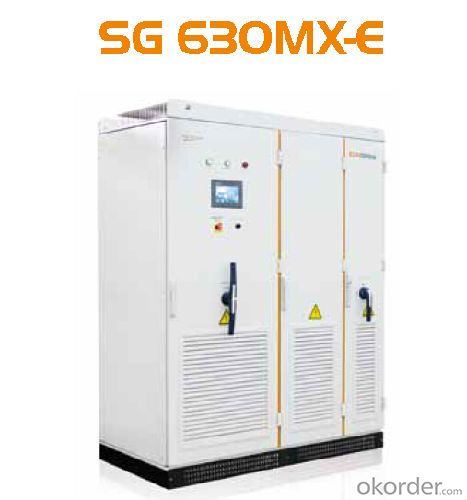
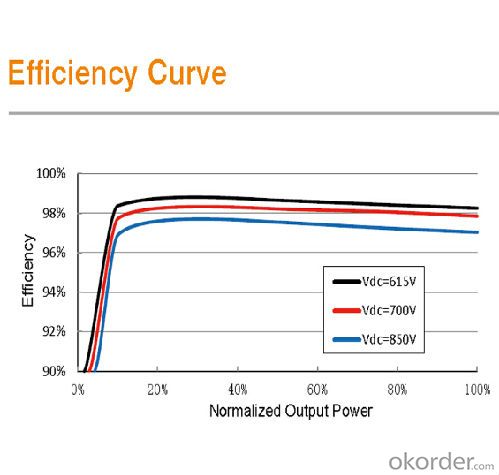
4. Photovoltaic Grid-Connected Inverter SG630MX-E Specification
Input Side Data | |
Max. PV input power | 713KW |
Max. PV input voltage | 1000V |
Startup voltage | 635V |
Min. operation voltage | 615V |
Max. PV input current | 1160A |
MPP voltage range | 615~850V |
No. of DC inputs | 8 |
Output Side Data | |
Nominal AC output power | 630kVA |
Max. AC output apparent power | 700KVA |
Max. AC output current | 1010A |
THD | < 3 % (Nominal power) |
Nominal AC voltage | 400V |
AC voltage range | 320V~460V |
Nominal grid frequency | 50/60Hz |
Grid frequency range | 47~52/57~62Hz |
Power factor | >0.99@default value at nominal power, (adj. 0.9 overexited ~0.9 underexited) |
Isolated transformer | No |
DC current injection | <0.5 %In |
Efficiency | |
Max. efficiency | 98.60% |
Max. European efficiency | 98.50% |
Protection | |
Input side disconnection device | DC load switch |
Output side disconnection device | AC load Switch |
DC overvoltage protection | Yes |
AC overvoltage protection | Yes |
Grid monitoring | Yes |
Ground fault monitoring | Yes |
Over temperature protection | Yes |
Insulation monitoring | Yes |
Surge arrester for auxiliary supply | Yes |
General Data | |
Dimensions(W×H×D) | 1606×2304×860mm |
Weight | 1700kg |
Operating ambient temperature range | -30~65℃(>55℃ derating) |
Night power consumption | <100W |
External auxiliary supply voltage | 400V |
Cooling method | Temperature controlled air-cooling |
Ingress protection rating | IP21 |
Allowable relative humidity range | 0~95% no condensing |
Max. operating altitude | 6000m (>3000m derating) |
Fresh air consumption | 4500 m3/h |
Display | Colored touch screen |
Communication | RS485/Modbus, Ethernet(Opt.) |
5. FAQ of Photovoltaic Grid-Connected Inverter SG630MX-E
Q1. What is the difference between inverter and solar inverter?
A1. Inverter only has AC inpput, but solar inverter both connect to AC input and solar panel, it saves more power
Q2. What is the difference between MPPT&PWM?
A2. MPPT has higher efficiency, it can track the max power point and won't waste energy.
- Q:Can a solar inverter be used with a solar tracker system?
- Yes, a solar inverter can be used with a solar tracker system. A solar inverter is responsible for converting the direct current (DC) produced by solar panels into alternating current (AC) that can be used to power electrical devices. A solar tracker system, on the other hand, is designed to maximize the efficiency of solar panels by orienting them towards the sun throughout the day. By using a solar inverter in conjunction with a solar tracker system, the generated electricity can be efficiently converted and used for various applications.
- Q:What are the common fault indications in a solar inverter?
- Common fault indications in a solar inverter can include error messages on the display panel, blinking lights, sudden shutdowns or restarts, abnormal noise, overheating, and fluctuations in power output.
- Q:What are the potential risks of over-discharging a battery connected to a solar inverter?
- The potential risks of over-discharging a battery connected to a solar inverter include reduced battery lifespan, damage to the battery cells, decreased battery capacity and performance, and potential safety hazards such as overheating or even battery failure.
- Q:Can a solar inverter be used with a solar-powered street lighting system?
- Yes, a solar inverter can be used with a solar-powered street lighting system. The solar inverter is responsible for converting the direct current (DC) generated by the solar panels into alternating current (AC) which is required to power the street lights. This ensures that the solar-powered street lighting system operates efficiently and effectively.
- Q:Can a solar inverter be connected to a home automation system?
- Yes, a solar inverter can be connected to a home automation system. By integrating the solar inverter with the home automation system, homeowners can monitor and control their solar power production, track energy usage, and automate various energy-saving functions such as adjusting thermostat settings, turning off appliances, or scheduling energy-intensive tasks during peak solar production hours. This integration enhances the overall efficiency and convenience of managing solar energy within a smart home environment.
- Q:Are there any disadvantages of using a solar inverter?
- Yes, there are a few disadvantages of using a solar inverter. Firstly, solar inverters are sensitive to extreme temperature variations, and their efficiency can be affected in very high or low temperature conditions. Secondly, solar inverters require regular maintenance and occasional replacement, which adds to the overall cost of the system. Additionally, solar inverters produce a small amount of electromagnetic interference (EMI) which can interfere with nearby electronic devices if not properly shielded. Lastly, solar inverters are grid-tied systems, meaning they rely on a stable electrical grid to function. In case of power outages or grid malfunctions, solar inverters may shut down and stop supplying power to the connected devices.
- Q:How does a solar inverter handle partial shading on solar panels?
- A solar inverter handles partial shading on solar panels by utilizing a technique called Maximum Power Point Tracking (MPPT). MPPT allows the inverter to continuously track the optimal operating point of each individual solar panel, even if some panels are partially shaded. By constantly adjusting the voltage and current levels of the panels, the inverter ensures that the shaded panels do not significantly affect the overall system performance, maximizing the energy output of the entire solar array.
- Q:What are the key factors affecting the warranty coverage of a solar inverter?
- The key factors affecting the warranty coverage of a solar inverter include the length of the warranty period, the terms and conditions outlined in the warranty document, the reputation and financial stability of the manufacturer, the quality and reliability of the inverter components, and any limitations or exclusions stated in the warranty.
- Q:Can a solar inverter be used with a wind turbine?
- Certainly! It is indeed possible to utilize a solar inverter alongside a wind turbine. Both wind turbines and solar panels generate direct current (DC) electricity, which necessitates conversion to alternating current (AC) in order to power the majority of household appliances and connect to the electrical grid. The primary function of a solar inverter is to convert DC electricity produced by solar panels into AC electricity. Interestingly, it can also perform the task of converting DC electricity generated by a wind turbine into AC electricity. However, it is worth mentioning that wind turbines typically produce higher voltage and fluctuating currents in comparison to solar panels. As a result, the inverter employed with a wind turbine may require specific design considerations to effectively manage these variations. Additionally, it is common for wind turbines to possess their own specialized inverters that are meticulously optimized to suit their unique electrical characteristics.
- Q:Can a solar inverter be integrated with energy management systems?
- Yes, a solar inverter can be integrated with energy management systems. By connecting a solar inverter to an energy management system, it allows for better monitoring, control, and optimization of the solar power generated. This integration enables efficient management of energy consumption, storage, and distribution, leading to increased energy efficiency and cost savings.
1. Manufacturer Overview |
|
|---|---|
| Location | |
| Year Established | |
| Annual Output Value | |
| Main Markets | |
| Company Certifications | |
2. Manufacturer Certificates |
|
|---|---|
| a) Certification Name | |
| Range | |
| Reference | |
| Validity Period | |
3. Manufacturer Capability |
|
|---|---|
| a)Trade Capacity | |
| Nearest Port | |
| Export Percentage | |
| No.of Employees in Trade Department | |
| Language Spoken: | |
| b)Factory Information | |
| Factory Size: | |
| No. of Production Lines | |
| Contract Manufacturing | |
| Product Price Range | |
Send your message to us
Photovoltaic Grid-Connected Inverter SG630MX-E Solar Inverter
- Loading Port:
- China Main Port
- Payment Terms:
- TT or LC
- Min Order Qty:
- 10 unit
- Supply Capability:
- 1000 unit/month
OKorder Service Pledge
OKorder Financial Service
Similar products
New products
Hot products
Hot Searches
Related keywords
